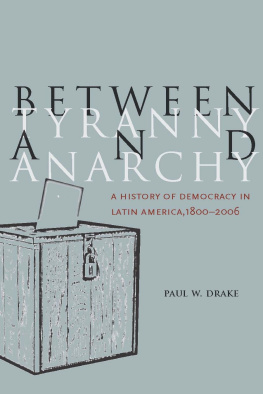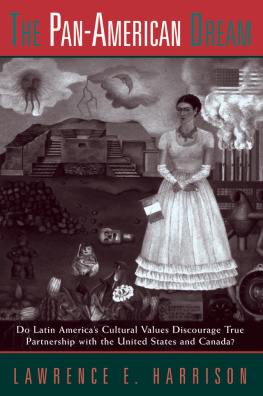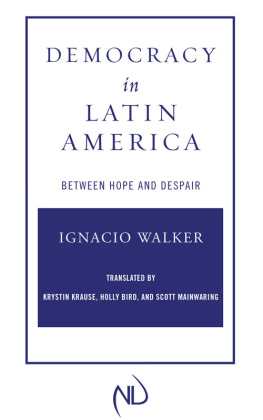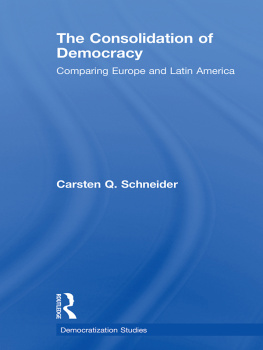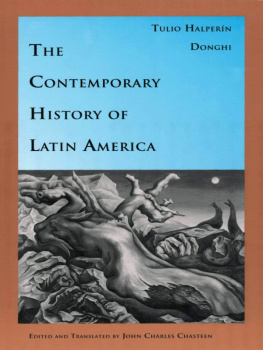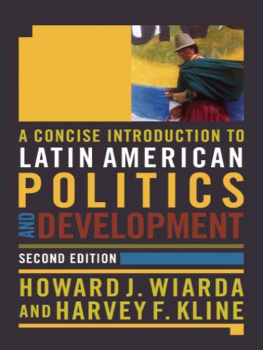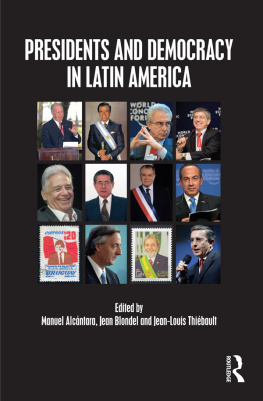SOCIAL SCIENCE HISTORY
Edited by
Stephen Haber and David W. Brady
Armando Razo, Social Foundations of Limited Dictatorship: Networks and Private Protection During Mexicos Early Industrialization
Stephen Haber, Douglass C. North, and Barry R.Weingast, editors, Political Institutions and Financial Development
David W. Brady and Mathew D. McCubbins, Process, Party, and Policy Making: New Advances in the Study of the History of Congress
Anne G. Hanley, Native Capital: Financial Institutions and Economic Development in So Paulo, Brazil, 1850 to 1920
Fernando Rocchi, Chimneys in the Desert: Argentina During the Export Boom Years, 1870 to 1930
J. G. Manning and Ian Morris, The Ancient Economy: Evidence and Models
Daniel Lederman, The Political Economy of Protection
William Summerhill, Order Against Progress
Samuel Kernell, James Madison: The Theory and Practice of Republican Government
Francisco Vidal Luna and Herbert S. Klein, Slavery and the Economy of So Paulo, 1750 to 1850
Noel Maurer, The Power and the Money
David W. Brady and Mathew D. McCubbins, Party, Process, and Political Change in Congress
Jeffrey Bortz and Stephen Haber, The Mexican Economy, 1870 to 1930
Edward Beatty, Institutions and Investment
Jeremy Baskes, Indians, Merchants, and Markets
Between Tyranny and Anarchy
A History of Democracy in Latin America, 1800-2006
Paul W. Drake
Stanford University Press
Stanford, California
2009 by the Board of Trustees of the Leland Stanford Junior University. All rights reserved.
No part of this book may be reproduced or transmitted in any form or by any means, electronic or mechanical, including photocopying and recording, or in any information storage or retrieval system without the prior written permission of Stanford University Press.
Printed in the United States of America on acid-free, archival-quality paper
Library of Congress Cataloging-in-Publication Data
Drake, Paul W., 1944
Between tyranny and anarchy : a history of democracy in Latin America, 18002006 / Paul W. Drake. p. cm.(Social science history)
Includes bibliographical references and index.
ISBN 978-0-8047-6001-0 (cloth : alk. paper)
9780804771054
1. DemocracyLatin AmericaHistory19th century. 2. DemocracyLatin AmericaHistory20th century. 3. Latin AmericaPolitics and government19th century. 4. Latin AmericaPolitics and government20th century. I. Title. II. Series: Social science history.
JL966.D73 2009 320.98dc22 2008038350
Typeset by Publishers Design and Production Services, Inc. in 10.5/13 Bembo
To Josh, Liz, and Katie Drake
PREFACE
When I told people I was writing a history of democracy in Latin America, I encountered some skeptical reactions. One person joked, Well, that will certainly be a short book. Another asked, Is there any such thing?
This book is longer than they (or I) expected. It shows that those questions set too high a standard for Latin America compared to the rest of the world. As a countercurrent to a deserved reputation for almost five centuries of overwhelming authoritarianism, the region exhibits a protracted and profound history of struggles for democracy. True, the result is mainly a tale of thwarted aspirations and dashed dreams, but it is also a journey toward progress.
I was drawn to this topic by the tidal wave of democratization that took place from the late 1970s to the 2000s. Many people welcomed that tsunami in the aftermath of the previous harsh dictatorships. It showed that democracy could prosper in Latin America, that previous experiences with that political system may have been underestimated, that there should be significant antecedents for the present paradigm, and that if democratic institutions are so worthy of study now they must have been in the past. Indeed, most of the concerns about democracy in recent years are not new, but they are issues that have consumed the region ever since independence.
In the last two decades, a new generation of graduate students in political science also lured me into this subject. Trained in the discipline in the new institutionalism and rational choice theory, they asked me to help them study democratic institutions in contemporary Latin America. As a seasoned Latin Americanist, I of course warned them that this endeavor was a colossal waste of time. Any fool knew that democratic institutions in the region rarely functioned properly and seldom lasted long. However, as those rules and organizations increasingly survived and elicited compliance from the 1980s to the 2000s, I had to go along with my students desires to probe such issues.
But then I ran into another problem. When the students discovered how political institutions functioned currently, they naturally asked me how that compared with their operation in earlier periods. This forced me to admit that I really knew very little about the matter. My cohort of historians and political scientists had not paid much attention to the question due to the often deplorable record of democracy in the region. Realizing that maybe democratic institutions were more important than I had thought, I decided that their history was a topic ripe for exploration. As an historian in a political science department, I found the project intriguing.
This book makes three broad contributions to understanding the evolution of Latin American democracy. First, it provides a comprehensive history of the regions efforts at democracy over two centuries in multiple countries. Second, it shows that most general theories of democracy can not adequately explain its trajectory in Latin America without a deep analysis of the historical context and causes. Third, it takes an interdisciplinary approach by weaving together the normally separated research on Latin American democracy by historians and political scientists.
By connecting the pioneering but seldom integrated work by historians and political scientists, this study links the past and the present across two disciplines. Although mainly historical in structure and methodology, it incorporates and addresses many of the current issues about democracy in political science. It bridges the two disciplines by emphasizing an institutional, rather than a sociocultural, approach to the history of democracy. It establishes that the ideas, behaviors, and institutions typical of Latin American democracies have deep roots.
An interpretive synthesis is, by nature, based mainly on secondary sources. This book owes an enormous debt to a treasure trove of older and newer literature. Four genres proved exceptionally useful. First, many sometimes overlooked classic books by both historians and political scientists still provided valuable insights. Second, another fruitful place to dig was largely forgotten academic writings from the 1950s to the 1970s, when political studies were shifting from descriptive, narrative, and institutional approaches to quantitative, theoretical, and behavioral methods. Third, the recent outburst of democratization has inspired an avalanche of sophisticated theoretical and empirical analyses by modern political scientists. Fourth, a new generation of historians has produced ground-breaking research on what democratic politics meant to ordinary people in bygone years, especially through elections.
This book offers an original combination and reinterpretation of these four bodies of work. It also rests on primary materials, including constitutions, laws, data on elections, polls, and coups, and statements by political actors, thinkers, and observers. The footnotes reference these items and indicate the extensive key literature.

